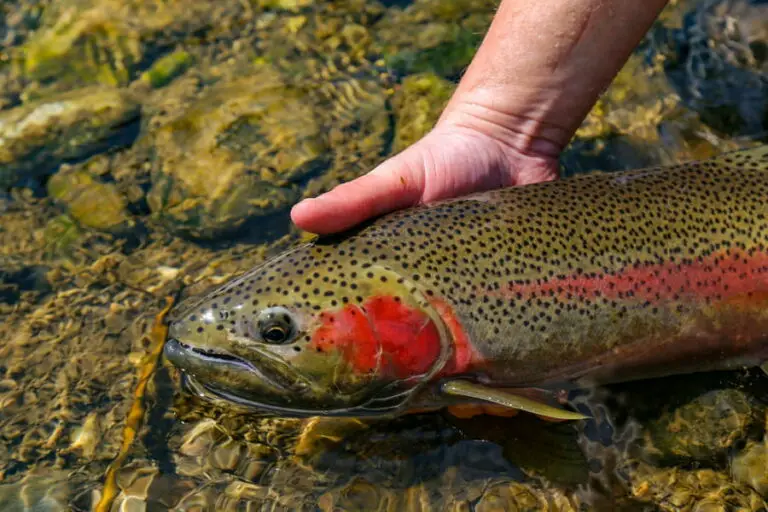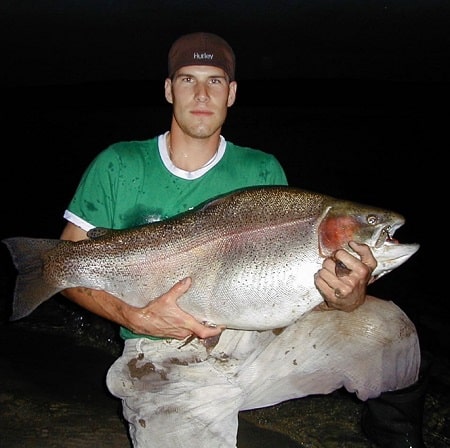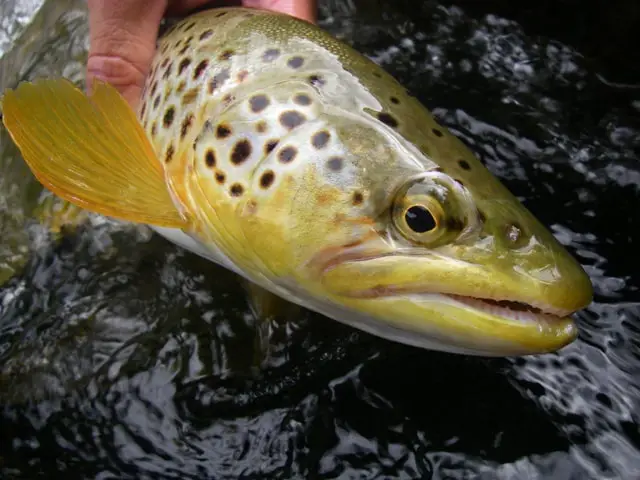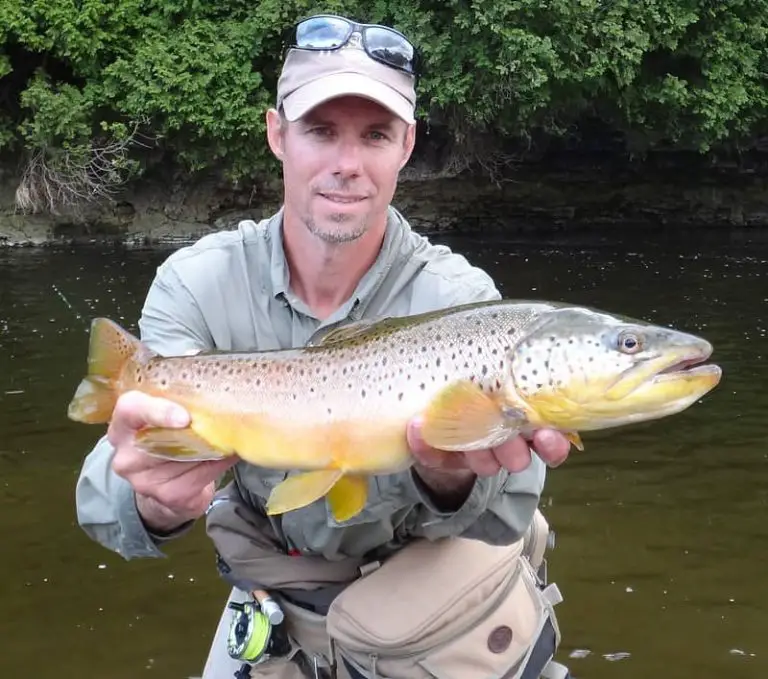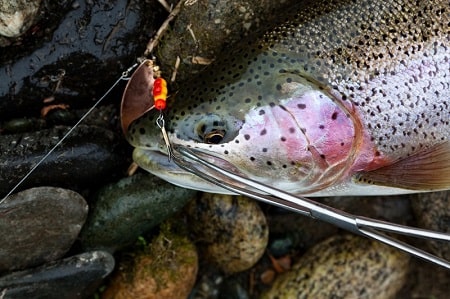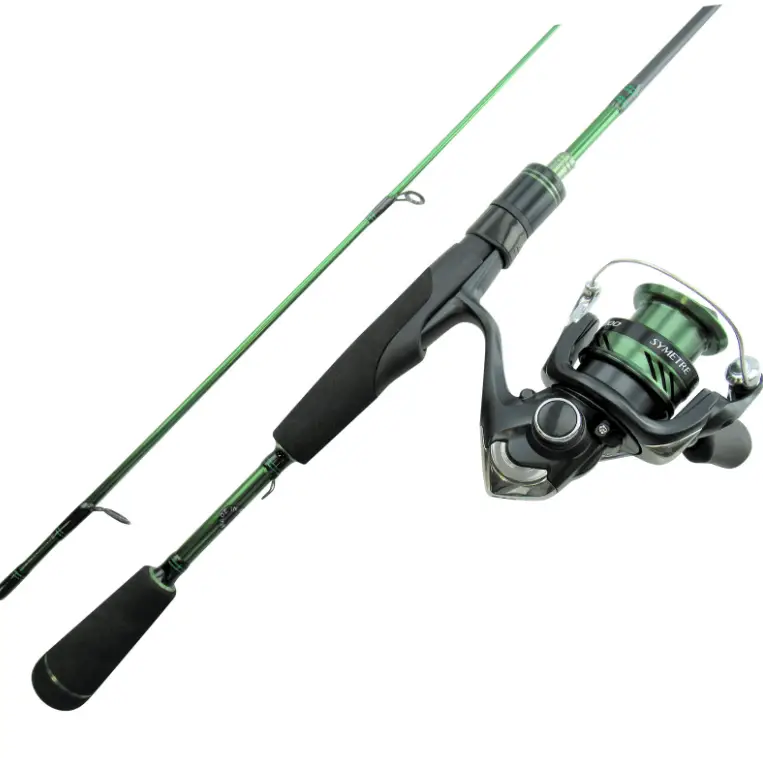Trout Fishing Gear: The 5 Essentials & More
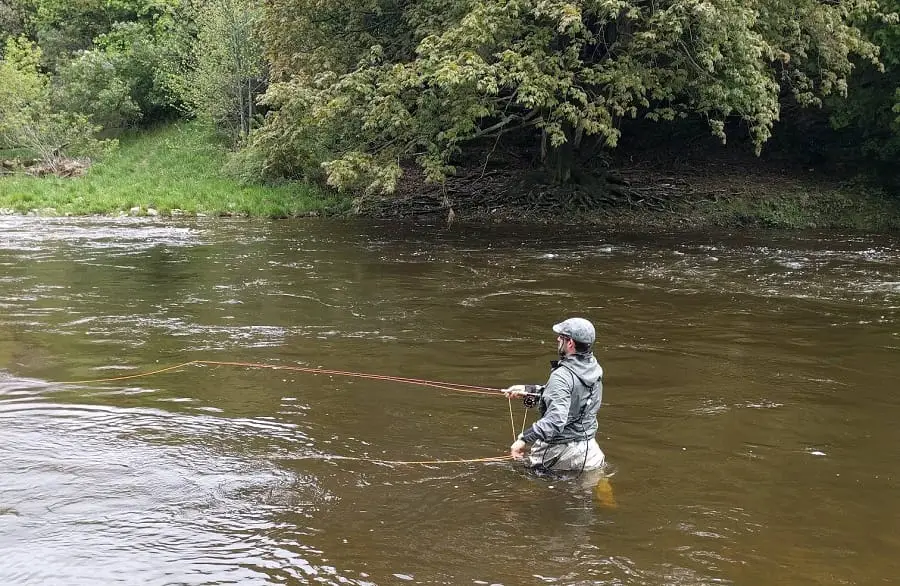
If you’re reading this, you’re probably looking to gear up with the required fishing gear for trout, or you are interested in knowing the fishing gear that my guide team uses and recommends to our clients. Either way, we’ve got you covered.
The essential gear for trout fishing is:
- A trout rod and reel.
- Suitable line.
- Leader.
- Hooks.
- Weights.
- Baits.
- Lures.
- Waders.
- Wading Boots.
- Proper clothing for the conditions.
- Vest or pack or a tackle box.
- A Wading net.
- Accessories like forceps and nippers.
After all, as guides being on the water for over 200 days a year, we use a lot of gear and have tested many different types of gear, and now know exactly what is needed.
We may make a small commission from some of the links on this website, which is at no cost to you. I appreciate your support.
Fishing Rods For Trout
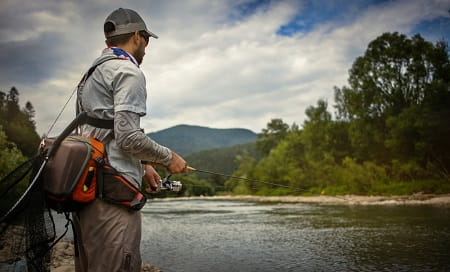
When it comes to a trout fishing rod for trout fishing, there’s no one-size-fits-all solution.
The trout fishing rod you want depends on the size of the trout and the type of water you fish or the size of the trout.
This guide will help you choose the right rod for you.
- Small streams (2 to 12 feet wide) and a 5- to 6-foot ultralight spinning rod are ideal and will work with baits and light lures.
- Medium Streams (12 to 30 feet wide), a 7 to 8-foot ultra-light rod is a good option. Or, for bigger fish or faster currents, a light-action or medium-light action rod will be better.
- Large Rivers, Fast Currents, Big Trout: On fast flowing large rivers with many bigger trout over 5 pounds, anglers and guides prefer a 7- to 8-foot medium action rod. Make sure the rod is sensitive and has a comfortable grip for all-day casting. This size rod is good for larger lures, bait fishing, float fishing, and for landing bigger fish.
- Float Fishing: If your primary method of fishing is float fishing for trout, I prefer longer rods in the 8 to 11-foot range in a light or medium-light action.
- Lakes And Ponds: A 7 to 8-foot medium action rod is ideal for fishing lures and baits.
Fishing Reels For Trout
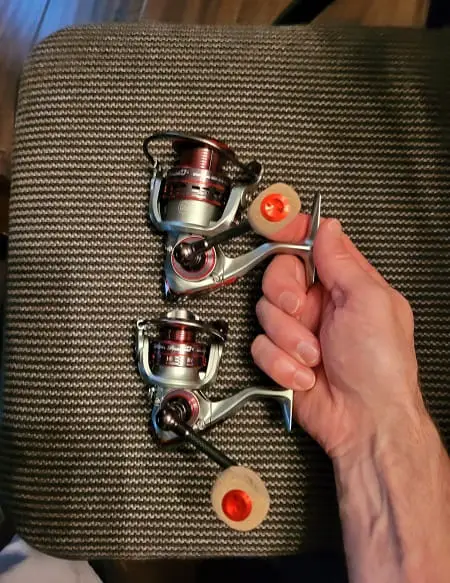
The perfect fishing reel for trout will be lightweight and durable, with a smooth drag system for handling bigger trout.
Depending on the brand, the reel size-rating system is by the tens or thousands. One brand’s small reel would be listed as a size 10, while another brand would list the same sized reel as a size 1000. Either way, the smaller number is the smaller reel.
- Small Streams and Small Trout: A size 1000 to 2000 spinning reel is ideal for most trout fishing in smaller streams and when faced with many smaller trout under 16 inches. I generally use size 1500/15 and size 2000/20 for most small to mid-sized rivers and trout that are under 8 pounds. I will match a size 1500 or 2000 reel with an ultralight rod for a great trout rod setup.
- Medium to Large River and Larger Trout: When trout fishing bigger rivers and trout 8 pounds and bigger, I use reel sizes of 2500/25 to 3500/35 reels.
- Lakes and Ponds: A 2500 to 3500 reel is what I use when fishing lakes and ponds.
When choosing a reel, you have the option to use the most common reel which is a spinning reel, or a baitcasting reel.
Either way, look for features like sealed bearings, quality materials, and a good line capacity.
Check out these great spinning outfits geared for trout fishing at Bass Pro Shop and Basspro.com
Not sure which reel to buy, check out our recently updated article Best Spinning Reels For Trout.
Line For Trout Fishing
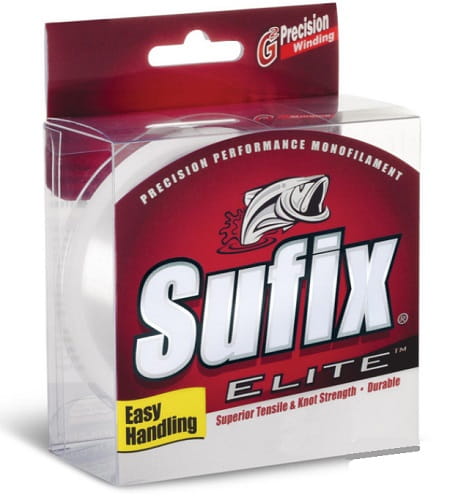
Trout have very good eyesight and they can be line shy, especially when using a slow-moving or still bait, so using a thin, low-visibility line is crucial if you want to consistently catch trout.
The Monofilament line is the most popular line with trout anglers.
Fluorocarbon is an excellent choice because it’s nearly invisible underwater and has low stretch, providing better sensitivity and abrasion resistance from rocks and logs.
For most trout fishing situations, most guides and anglers prefer a 4- to 6-pound test line. Consider a braided line between 10 and 20 pounds with a fluorocarbon leader for added strength and stealth when float fishing or when fishing lures in rivers.
There are many types of lines and brands of lines to choose from. Some are better and some are worse. Check out my article The Best Fishing Line For Trout: What The Guides Use.
Fly Rod and Reels For Trout
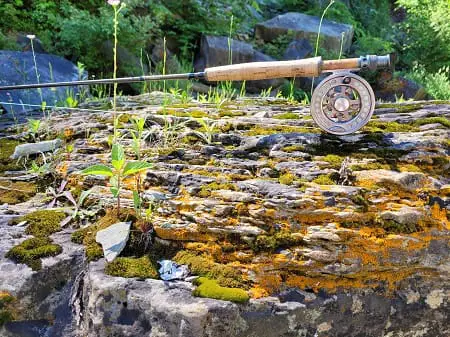
Fly fishing is a very popular way to catch trout in rivers and it is my preferred way of river fishing for trout. Many river guides will only offer fly fishing, which shows the effectiveness of this method.
Catching trout on fly rods is a lot of fun, but not all fly rods should be used for trout fishing.
When fly fishing, I use and recommend these sizes:
- Small Stream, Small Trout, Light or Small flies: a three or 4-weight rod combined with a three or 4-weight reel and a floating weight-forward fly line.
- Medium-Sized Rivers (30 to 50 feet wide). Bigger Trout, Bigger Flies: a 9-foot, 5-weight fly rod is a versatile choice for most trout fishing situations. It will even fish well in larger streams and with most flies, including larger streamer flies.
I discuss the best fly rods for trout on my page 15 Best Fly Rods For Trout: Best Fly Rods For All Budgets.
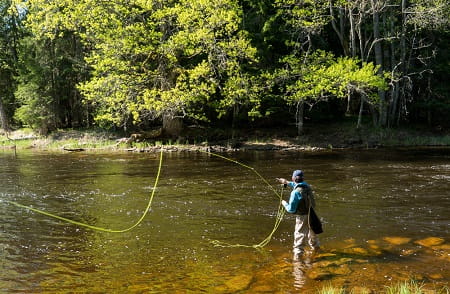
The Fly Reel: Pair your fly rod with a matching fly reel that has a smooth drag system and sufficient line capacity.
A large arbor design will help with quick line retrieval, and an easily adjustable drag will help you land those trophy trout.
For most trout fishing I use a floating line on my fly reel with a standard leader.
Add a standard 9-foot tapered leader, a tippet, and some flies, and pick a method of fly fishing and go get them.
For more on the methods, best rods and reels, setups, and the best flies check out Fly Fishing For Trout: A Complete Guide.
Waders and Boots
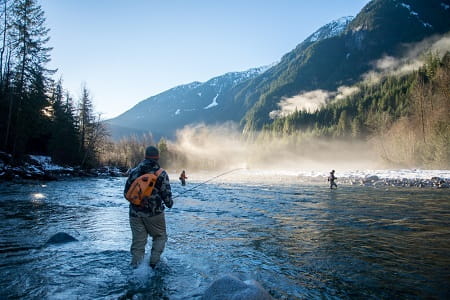
Anglers use chest waders or hip waders when fishing rivers. I personally prefer chest waders and feel that they are essential trout gear.
Waders do a few things for the trout angler, which can be very important and can increase the amount of trout you catch.
- Waders keep you dry, warm, and comfortable
- Waders protect your legs and lower body from cuts and scraps from rocks, logs, branches, insect bites, and poisonous plants.
- Waders allow you to get into a better position in the river which will allow you to catch more trout.
Some waders come with built-on boots, and although these are okay for trout fishing they offer less ankle support. Other waders are known as neoprene stocking foot waders, and you need to put wading boots overtop of them.
Stocking foot waders are my preferred choice and the preferred choice of most or all trout fishing river guides.
Pair your waders with comfortable, supportive wading boots that have good traction for navigating slippery rocks. Consider felt or rubber soles, depending on local regulations and personal preference.
Fishing Vests And Fishing Packs For Trout
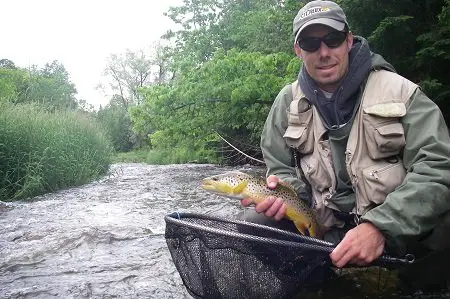
A fishing vest or pack is trout gear I always use, and so does every guide I know.
Most anglers that fish rivers do not use a tackle box.
Instead, they pack all their gear, such as flies, baits, lures, weights, lines, into a vest or pack so that they can carry it everywhere they go.
This way, it’s hands-free even when wading deep into the river or lake.
A well-organized fishing vest or pack is crucial for keeping all your gear within reach. Look for one with plenty of pockets and compartments, as well as attachment points for tools like hemostats and nippers. Comfort is key, so choose a vest or pack with padded straps and a breathable back panel.
Check out my article 21 Best Fishing Vests Of 2023: Recommended By River Guides and Best Fly Fishing Packs And River Fishing Packs That The Guides And Top Anglers Use.
Baits For Trout
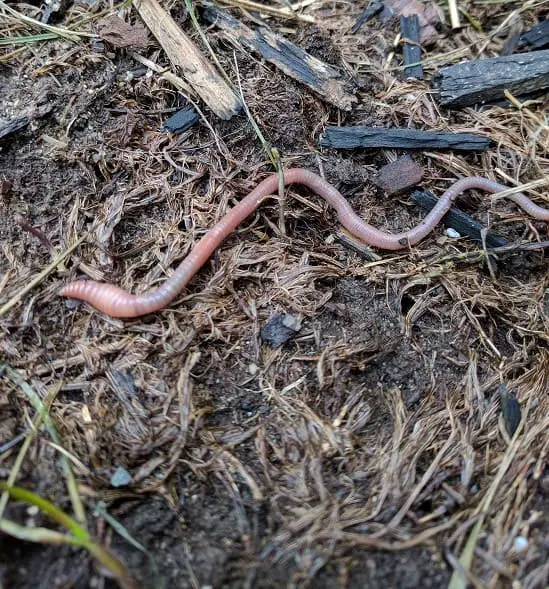
Natural baits like worms, minnows, and insects can be highly effective for enticing trout in both rivers and lakes. There are some baits that just work better and trout guides know what those baits are.
Some baits are just not that effective so I never use them, despite them being recommended by tackle shop employees and advertisements.
Artificial flies are also a bait that can be used by spin fishermen and bait fishermen. Flies are not just for fly anglers and can be used when float fishing, bottom bouncing, and drift fishing.
Check my page How To Fish Flies With Spinning Gear: 2 Best Methods, and 29 Best Trout Flies: Modern Flies Used By River Guides.
I always have a variety of baits on hand, and I will experiment to see what works best for the trout and the conditions when I’m fishing or guiding. Check out Best Trout Bait – The Only 5 Baits You Will Ever Need
Lures For Trout
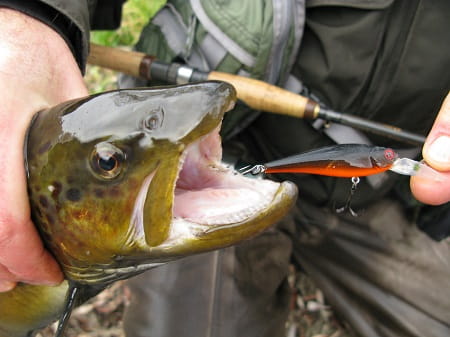
Lure fishing for trout can sometimes be the most effective method for big and smaller fish and many anglers will have their favorite lure, which are usually spinners, but there are many effective lures to try.
Spoons, spinners, and crankbaits are all popular choices for trout fishing on a stream. I also use plugs and jigs for trout.
Typically, the same spinners used for other species like bass will also work very well on rainbow trout, browns, and brookies.
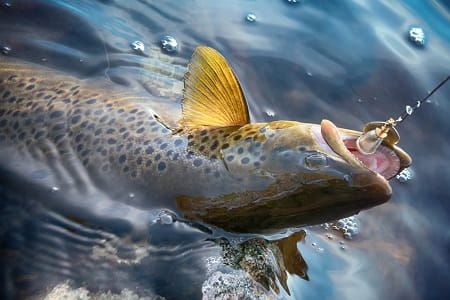
The key with spinners, spoons, and crankbaits is to match the size and color of the lure to the natural prey in the area. Black, silver, and gold are always safe bets, but don’t be afraid to try brighter colors in murky water or on overcast days.
Lures in the 1 to 5-inch size will work with 2 to 3 inches being my go-to size for all trout sizes. For bigger trout, 3 to 4 inches is my preferred lure size.
If you are not using lure fishing methods used by top river guides near you, then you are probably not catching as many fish as you should be. Check out Lure Fishing For Trout: Tactics From A Pro River Guide.
Nets and Creels
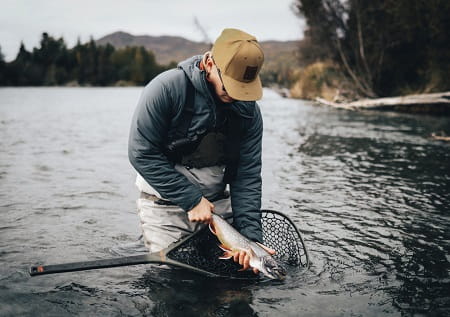
A good trout net is essential for safely landing and releasing trout, and it might also prevent you from losing that trout of a lifetime.
Look for one that is made for trout fishing in a river, also known as a wading net or a landing net.
It should be light and portable so it can go with you when wading out deep in the river or lake.
I recommend a wading net with a rubber, rubber-coated, or silicone netting material to protect the fish’s delicate slime coat.
An oversized landing net that is heavy with long handles is tough when walking through the bush and when wading rivers so avoid those nets. Check out 5 Best Trout Nets And A Guides Advice On How To Attach Them
A creel is useful for keeping your catch fresh until you’re ready to head home. Choose a creel with a built-in liner and plenty of ventilation to ensure your trout stay cool and moist.
Hats and Sunglasses
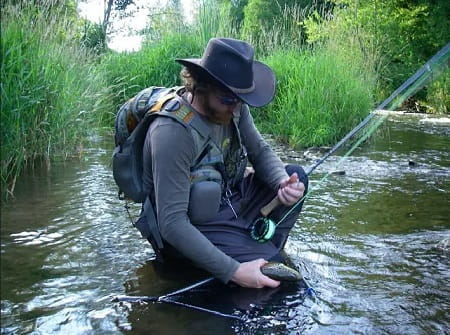
Something often missed by many anglers and something I think is essential gear for trout fishing is a hat and sunglasses.
Believe it or not, a hat and glasses will help you catch more trout, and I don’t fish without them.
Just look at pictures of trout guides fishing or standing beside their clients and they always have a hat and glasses on.
Protecting yourself from the sun is vital during long days on the water but a hat keeps the sun out of your eyes, which helps you see into the water to locate holding and feeding water and maybe even help you see big fish. A wide-brimmed hat or a cap with a neck flap will shield you from harmful UV rays.
Polarized sunglasses are a must-have, as they reduce glare and allow you to see beneath the water’s surface, helping you spot fish and underwater structures where trout will hold and feed.
As a guide, my glasses have resulted in my clients catching some very large trout and have helped me see trout and learn about their feeding and resting behaviors.
Clothes For Trout Fishing
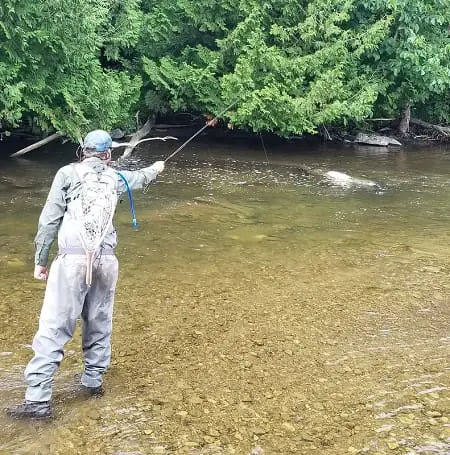
The clothes you wear matter for a few reasons.
First, wear drab colored clothes in green or tan so that you blend into your surroundings and so you spook less trout.
Dressing in layers is key for staying comfortable in varying weather conditions.
Start with moisture-wicking base layers, add insulating layers for warmth, and finish with a waterproof, breathable shell. Don’t forget quick-drying pants or shorts and a UV-protective shirt for sun protection.
Layering your clothes allows you to remove clothing when too hot, or add clothing when you get cool.
Proper clothing can include:
- Wading Jacket
- Raincoat
- Hats
- Hoodie
- Sun shirt
- Gloves
- Neck Gaitor
I discuss all this and more on my page River Fishing Gear: Everything You Need To Succeed In 2023
Tackle Boxes And Fly Boxes
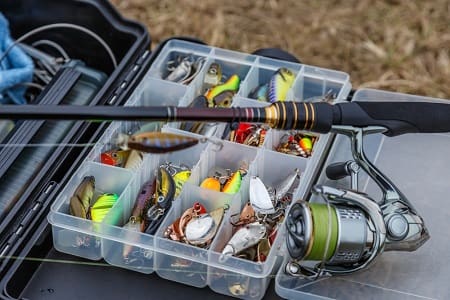
Organizing your tackle is crucial for efficient fishing but I only use a tackle box on the boat or when fishing a lake or pond.
A quality tackle box with adjustable compartments will keep your lures, hooks, and weights organized and easily accessible.
Fly anglers should invest in a sturdy fly box with foam or silicone inserts to keep their flies secure and dry.
Accessories Used For Trout Fishing
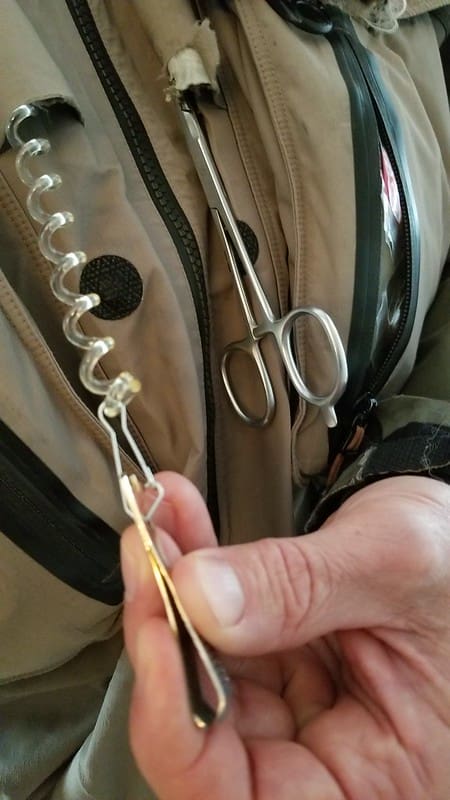
Accessories and terminal tackle wrap up the fishing gear you will need for trout.
Terminal Tackle: Your terminal tackle will include weights, and an assortment of hooks, swivels or tippet rings, indicators, and floats.
GUIDE TIP: Using the right hook and the right hook size will ensure you will catch more trout. check out 11 Best Hooks For Trout: What The Guides Use.
Forceps: Accessories include a good pair of hemostats which are also known as forceps which are important for hook removal and other tasks. I use forceps on almost every single trout fishing trip.
Nippers: A sharp line clipper or nipper will help you quickly trim knots and change tackle. I use nippers on every trout fishing trip. I attach mine with a retractor that you can get and most stores.
Pocket Knife: A compact folding knife is handy for cutting bait or other general tasks, while a sturdy measuring tape or ruler will ensure you’re staying within legal catch limits.
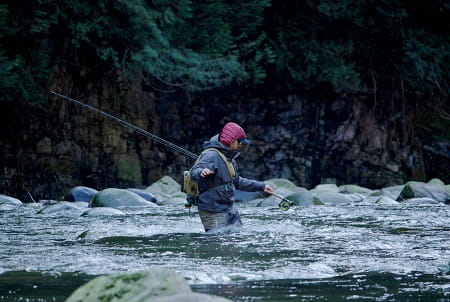
Wading Staff: A wading staff is highly recommended for a new angler and for an angler that are not very sturdy when crossing a river or wading on the rocks.
Both good wading boots and a good staff can help you access spots others can’t get to.
Best Trout Fishing Gear For Beginners Conclusion
Now that you’re equipped with all the knowledge you need to get the right trout fishing gear, it’s time to learn the most effective methods before you hit the water and put your skills to the test!
With the right equipment and some practice with those methods, catching trout will be much easier. Got a question, let me know.
Tight Lines
Graham

